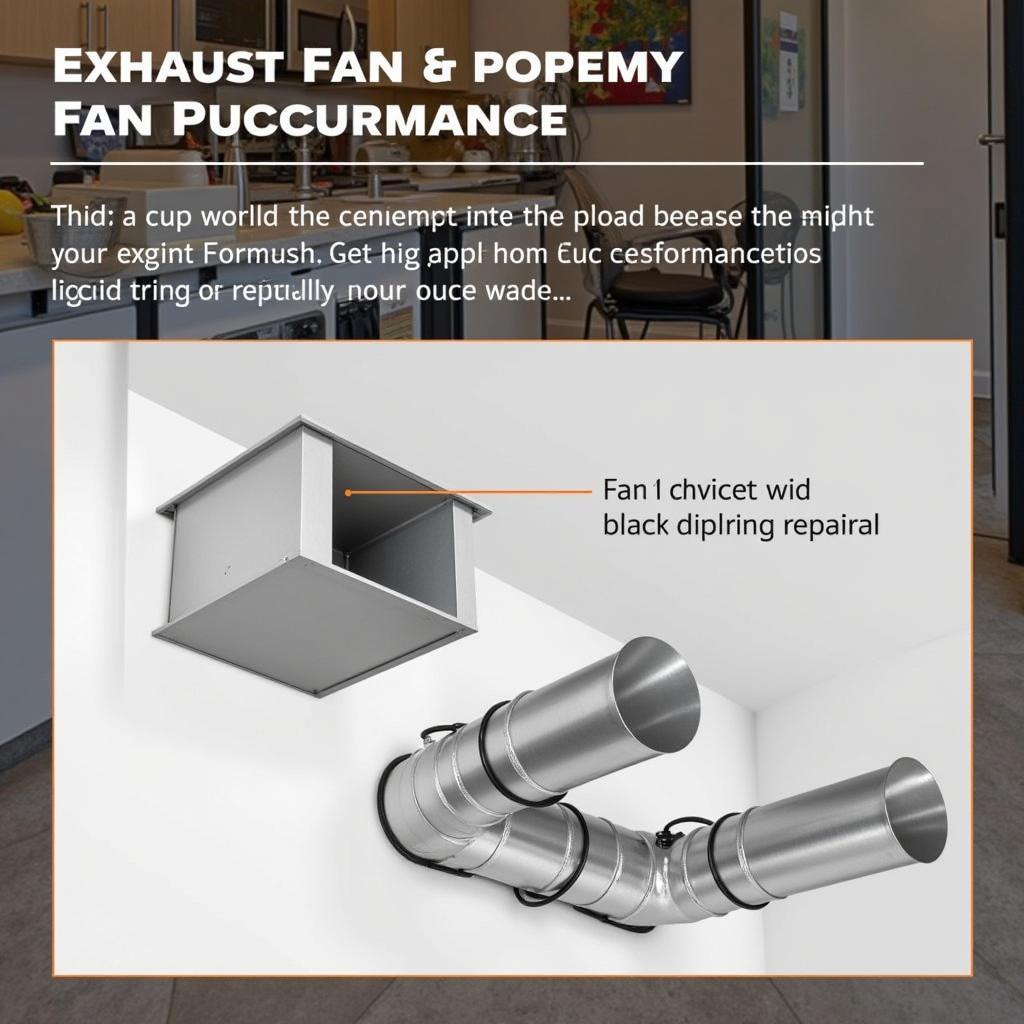Exhaust Fan Parameter Properties are crucial for selecting the right fan for a specific application. Whether you’re ventilating a small bathroom or a large industrial warehouse, understanding these properties ensures optimal performance and efficiency. Choosing the wrong fan can lead to inadequate ventilation, increased energy costs, and even potential safety hazards.
Understanding the key parameters allows you to compare different models and choose the most suitable option. These properties are interconnected and influence each other, creating a complex system that needs careful consideration. For example, a higher airflow rate might require a more powerful motor, impacting both the fan’s noise level and energy consumption. Just after this introduction, let’s delve into the core aspects of exhaust fan parameters. Check out our resource on industrial fan parts repair for more information about maintaining your fans.
Key Exhaust Fan Parameters
Several key parameters define an exhaust fan’s performance and suitability for various applications. These include airflow, static pressure, power consumption, noise level, and fan size. Let’s explore each of these in detail.
Airflow (CFM)
Airflow, measured in cubic feet per minute (CFM), indicates the volume of air the fan can move in one minute. A higher CFM means the fan can exchange air more quickly, making it suitable for larger spaces or applications requiring rapid ventilation. Determining the required CFM for your space involves considering factors like room size, occupancy, and the type of activity taking place.
Static Pressure (SP)
Static pressure, measured in inches of water gauge (WG), represents the resistance the fan overcomes to move air through the ductwork or ventilation system. Higher static pressure indicates greater resistance, often due to longer or more complex duct systems. Understanding the static pressure requirements of your ventilation system is essential for selecting a fan capable of effectively moving air against the existing resistance.
Power Consumption (Watts)
Power consumption, measured in watts, reflects the amount of electricity the fan uses during operation. A lower wattage means the fan is more energy-efficient, resulting in lower operating costs. Choosing an energy-efficient fan can significantly reduce long-term energy expenses.
Noise Level (dB)
Noise level, measured in decibels (dB), indicates the sound produced by the fan during operation. Lower dB ratings signify quieter operation, which is crucial for residential or office environments where noise pollution is a concern.
Fan Size
The physical dimensions of the fan are crucial for ensuring proper fit within the designated installation space. Carefully measure the available space before selecting a fan to avoid compatibility issues. You might find our article on fan revit family helpful when planning your installation.
Selecting the Right Exhaust Fan
Selecting the right exhaust fan involves carefully balancing these key parameters to meet the specific requirements of your application. For instance, a bathroom requires a fan with sufficient CFM to remove moisture and odors, while a large industrial space demands a high CFM fan capable of handling higher static pressure.
Matching Fan Parameters to Application Needs
Understanding the relationship between these parameters and your specific needs is crucial for optimal performance. A high CFM fan might not be necessary for a small room, while a low static pressure fan may be inadequate for a complex ventilation system.
 Exhaust Fan Static Pressure Chart
Exhaust Fan Static Pressure Chart
How to Calculate Required CFM?
Calculating the required CFM for a room involves considering its volume and the desired air changes per hour (ACH). For example, a 10x10x8 ft room with a desired 8 ACH requires a fan with a CFM of (10x10x8x8)/60 = 106.7 CFM.
John Ventilation Expert, a leading HVAC consultant, states, “Choosing the right CFM is paramount for effective ventilation. Too low, and you risk inadequate air exchange; too high, and you waste energy.”
Considering Ductwork and Ventilation System Design
The design of your ductwork and ventilation system significantly impacts the required fan performance. Longer ducts and more complex systems increase static pressure, requiring a fan capable of overcoming this resistance. Our guide on centrifugal fan housing design offers valuable insights into optimizing your ventilation system design.
 Exhaust Fan Ductwork Example
Exhaust Fan Ductwork Example
Maria Airflow Specialist, a renowned ventilation engineer, emphasizes, “Don’t underestimate the impact of ductwork on fan performance. Proper design and installation are essential for maximizing efficiency.”
Conclusion
Understanding exhaust fan parameter properties, including airflow, static pressure, power consumption, and noise level, is vital for selecting the right fan for your specific needs. By carefully considering these factors and matching them to your application requirements, you can ensure optimal ventilation performance, energy efficiency, and a comfortable environment. Considering these properties helps ensure you choose the best exhaust fan for your needs.
FAQ
- What does CFM stand for? CFM stands for Cubic Feet per Minute.
- How do I calculate the required CFM for my room? Calculate the volume of your room and multiply it by the desired air changes per hour (ACH), then divide by 60.
- What is static pressure? Static pressure is the resistance the fan overcomes to move air.
- How does ductwork affect fan performance? Ductwork design impacts static pressure, which affects the fan’s ability to move air.
- What is the importance of noise level in fan selection? Noise level is crucial for maintaining a comfortable environment, especially in residential or office settings.
- How do I choose the right fan size? Measure the available installation space to ensure proper fit.
- What is the relationship between airflow and static pressure? They are inversely related; as static pressure increases, airflow decreases.
Need help choosing the right exhaust fan? Contact us at Phone: 0903426737, Email: fansbongda@gmail.com or visit us at Lot 9, Area 6, Gieng Day Ward, Ha Long City, Quang Ninh, Vietnam. Our 24/7 customer service team is ready to assist you.


